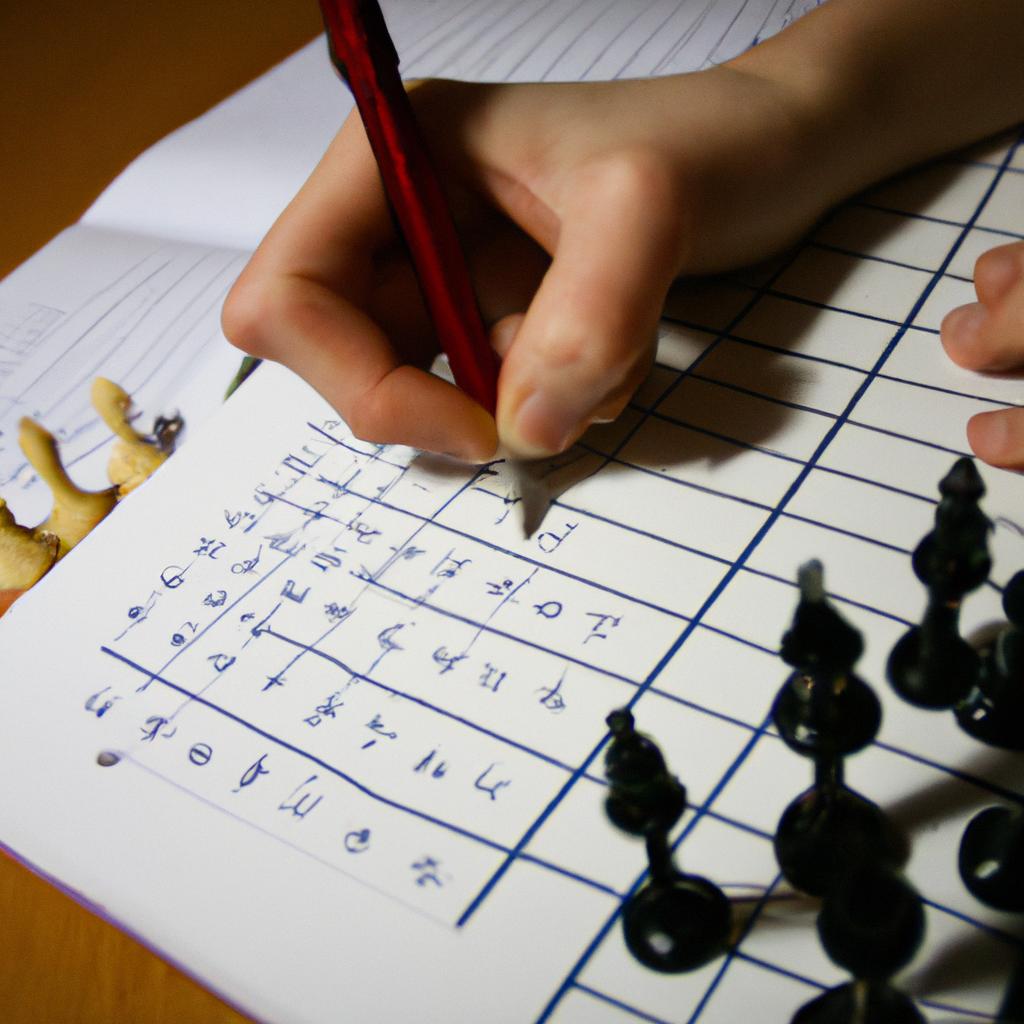Chess tactics are an essential aspect of the game, offering strategic maneuvers that can tip the scales in favor of one player over another. These tactical moves involve precise calculations and careful planning to outmaneuver opponents and gain a positional advantage. For instance, consider a hypothetical scenario where a chess player finds themselves in a seemingly disadvantageous position with their pieces scattered across the board. By employing effective tactical strategies, they manage to orchestrate a series of surprising moves that not only safeguard their vulnerable pieces but also launch a counterattack against their opponent’s strongholds.
In games and sports, understanding chess tactics is akin to unlocking the secrets behind successful gameplay. The ability to identify advantageous positions on the board, exploit weaknesses in an opponent’s defense, and anticipate potential threats is crucial for achieving victory. Through proper training and practice, players can enhance their cognitive skills such as critical thinking, problem-solving abilities, pattern recognition, and foresight – all of which contribute to improved decision-making during gameplay. Moreover, mastering various chess tactics equips individuals with valuable transferable skills applicable beyond the realm of chess itself; these skills foster logical reasoning capabilities that may be utilized in diverse areas such as business strategy formulation or military planning.
Within this article lies an exploration into the world of chess tactics, delving into different types of tactical maneuvers and providing examples to illustrate their practical application. By understanding the underlying principles behind these tactics, players can develop a deeper appreciation for the intricacies of chess and expand their strategic repertoire.
One common type of chess tactic is the pin, where a piece is immobilized because moving it would expose a more valuable piece behind it to capture. We will explore various ways in which pins can be utilized to gain an advantage on the board.
Another important tactic is the fork, which involves attacking two or more pieces simultaneously with one move. Forks often force opponents into difficult decisions as they struggle to defend against multiple threats simultaneously.
Skewers are another fascinating tactical concept where an opponent’s piece is attacked, forcing them to move it and reveal a more valuable piece stationed behind it. This tactic combines both offense and defense by attacking one piece while indirectly targeting another.
We will also discuss other tactics such as discovered attacks, double attacks, decoys, deflections, and many more. Each tactic has its own nuances and strategic implications that can significantly impact gameplay outcomes.
Furthermore, this article will provide tips on how to spot tactical opportunities during games and offer advice on how to improve tactical awareness through practice. Chess puzzles and exercises will be included to challenge readers’ abilities in recognizing patterns and applying tactical concepts effectively.
By exploring the world of chess tactics in this article, readers will gain a deeper understanding of the game’s complexity and enhance their overall gameplay strategies. Whether you are an amateur player seeking to improve your skills or an experienced player looking for new insights, this exploration into chess tactics aims to equip you with knowledge and tools necessary for success on the board.
Understanding Tactical Concepts
Chess is a game of strategy and skill, where players must carefully plan their moves to outmaneuver their opponents. One essential aspect of this planning is understanding tactical concepts. By grasping these concepts, players can identify opportunities for advantageous moves and gain an upper hand in the game.
To illustrate the importance of tactical concepts, consider the following example: imagine a scenario where a player’s pieces are strategically positioned around their opponent’s king. The player recognizes that by sacrificing a pawn, they can initiate a series of moves that will ultimately lead to checkmate. This situation highlights how crucial it is to understand tactics and exploit them effectively.
Understanding tactical concepts involves several key elements:
- Piece Coordination: Coordinating one’s pieces allows for more efficient attacks and defenses. When multiple pieces work together harmoniously, they create threats that are difficult for the opponent to counter.
- Calculating Possibilities: Anticipating potential outcomes through calculation helps players make informed decisions. Calculating different move sequences enables players to assess risks and rewards before executing their chosen moves.
- Spatial Awareness: Recognizing spatial relationships on the chessboard aids in identifying strategic advantages or weaknesses. Evaluating open lines, squares, and diagonals allows players to position their pieces optimally for future attacks or defense.
- Pattern Recognition: Identifying recurring patterns in previous games enhances decision-making skills during gameplay. Familiarity with common tactics such as forks, pins, skewers, and discovered checks gives players an advantage when detecting similar opportunities.
By incorporating these tactical concepts into their gameplay strategies, chess enthusiasts can enhance their performance on the board significantly.
| Concept | Definition |
|---|---|
| Piece Coordination | The effective collaboration between multiple pieces leading to advantages |
| Calculating Possibilities | Assessing potential outcomes through thorough calculations |
| Spatial Awareness | A keen understanding of spatial relationships and their strategic impact |
| Pattern Recognition | Identifying recurring patterns to aid in decision-making during gameplay |
Understanding tactical concepts is a fundamental step toward becoming a skilled chess player. By developing these skills, players can confidently navigate the complexities of the game and seize advantageous opportunities. In the subsequent section, we will explore how identifying weaknesses in the opponent’s position further enhances one’s ability to strategize effectively.
Identifying Weaknesses in the Opponent’s Position
Having gained a solid foundation in tactical concepts, let us now explore the crucial skill of identifying weaknesses in the opponent’s position. To illustrate this concept, consider a hypothetical scenario where you are playing as white and your opponent has just moved their pawn to e5, leaving their d5 square vulnerable.
Identifying such vulnerabilities is essential for formulating effective strategies and executing successful tactics. Here are some key points to keep in mind when assessing an opponent’s position:
- Exploit weak squares: Weak squares are positions on the board that lack protection or can be easily attacked by your pieces. By recognizing these weak squares, you can maneuver your own pieces to occupy them and launch powerful attacks.
- Target unprotected pieces: Pieces that are not adequately defended present opportunities for capturing material or forcing unfavorable exchanges. Keeping an eye out for available targets will allow you to take advantage of any lapses in your opponent’s defensive setup.
- Assess pawn structure: The arrangement of pawns plays a significant role in determining potential weaknesses within a position. Pawns with structural flaws can become prime targets for undermining an opponent’s defenses and creating imbalances on the board.
- Evaluate king safety: A vulnerable king presents an opportunity for launching aggressive attacks or initiating mating patterns. Identifying weaknesses around the enemy king allows you to focus your efforts towards exploiting those areas efficiently.
To further understand how identifying weaknesses leads to successful gameplay, refer to the following table showcasing two contrasting scenarios:
| Scenario | Opponent’s Position | Outcome |
|---|---|---|
| Strong Position | Well-defended pieces | Limited attacking possibilities |
| Weak Position | Unprotected knight | Exploited through tactical strikes |
By being attentive to these strategic considerations, players enhance their ability to capitalize on positional imbalances and secure advantageous positions.
In our next section about “Calculating Variations and Combinations,” we will delve into the analytical aspect of chess, where we learn how to evaluate different move sequences and combinations. Understanding tactical concepts and identifying weaknesses in the opponent’s position sets the stage for this next crucial step towards becoming a formidable chess player.
Calculating Variations and Combinations
Transitioning from the previous section, where we explored identifying weaknesses in the opponent’s position, we now turn our attention to analyzing tactical possibilities. Understanding and calculating variations and combinations is crucial for any chess player aiming to outmaneuver their opponent.
Consider this hypothetical scenario: You are playing as White against a skilled opponent who has skillfully developed their pieces. However, you notice that the Black King lacks adequate protection due to an open file on its side of the board. This vulnerability presents an opportunity for you to exploit tactically by initiating an attack on the enemy king.
To effectively analyze tactical possibilities, keep these key points in mind:
- Visualization: Visualize different piece placements and moves before executing them on the board. This mental exercise helps identify potential threats or advantageous positions.
- Calculation: Accurate calculation is paramount when assessing variations and combinations. Carefully evaluate each move’s consequences, considering both immediate outcomes and long-term implications.
- Pattern Recognition: Develop your ability to recognize recurring patterns in different scenarios. Familiarity with common tactics such as pins, forks, skewers, and discovered attacks enables faster identification during gameplay.
- Evaluation: Continuously assess the advantages gained or risks involved after executing specific tactical maneuvers. Evaluating whether a particular variation leads to material gains, positional superiority, or checkmate opportunities will guide your decision-making process.
Table Example:
| Opening Move | Advantages | Disadvantages | Risk Level |
|---|---|---|---|
| e4 | Rapid development | Vulnerable center | Moderate |
| d4 | Solid control | Slower mobility | Low |
| c4 | Flexible options | Weaker pawn cover | High |
Analyzing tactical possibilities enhances your overall strategic understanding of the game while equipping you with tools for finding creative solutions even in complex positions. By considering the factors mentioned above, you can make informed decisions that maximize your chances of success.
Transitioning into the subsequent section about developing a solid opening strategy, we delve into crafting an effective plan for the initial stages of the game. Understanding tactical possibilities lays a strong foundation for building upon these ideas and executing them successfully during the opening phase.
Developing a Solid Opening Strategy
Building upon the ability to calculate variations and combinations, the next crucial aspect in developing a strong chess game is establishing a solid opening strategy. By strategically positioning your pieces at the beginning of the game, you can gain an advantage over your opponent and set yourself up for success throughout the match.
Opening Strategy: The Opening Moves
One example of an effective opening move is known as the “King’s Pawn Opening,” where players begin by moving their king’s pawn forward two spaces. This move aims to control the center of the board and create opportunities for further development. From this point, various responses are possible, leading to different opening systems such as Sicilian Defense or French Defense.
To develop a successful opening strategy, consider incorporating these key principles:
- Control the Center: Occupying central squares gives your pieces more mobility and allows for quicker coordination.
- Develop Minor Pieces: Prioritize developing knights and bishops early on to establish a strong foundation for future attacks.
- Protect Your King: Castle early to improve king safety and connect rooks for potential endgame advantages.
- Maintain Flexibility: Avoid committing too early with pawn moves that limit piece mobility. Instead, focus on maintaining flexibility and adaptability in response to your opponent’s actions.
Emotional Response Bullet Points:
- Confidence – A well-executed opening strategy instills confidence in players from the start, setting a positive tone for future decisions.
- Excitement – Successfully implementing an opening plan can lead to exciting tactical opportunities that keep players engaged throughout the game.
- Frustration – Poorly executed or unfamiliar openings may result in frustration if opponents exploit weaknesses or gain significant positional advantages.
- Determination – Strategically planning one’s opening moves demonstrates determination and dedication to improving gameplay skills.
| Principles | Key Actions |
|---|---|
| Control | Occupy central squares |
| Development | Focus on minor piece |
| Protection | Early king safety |
| Flexibility | Avoid early pawn commits |
Recognizing Tactical Patterns: The Next Step
Building a solid opening strategy sets the foundation for recognizing tactical patterns that can further enhance your gameplay. By studying common combinations and tactics, you will be better equipped to identify opportunities to gain material advantage or launch effective attacks. In the subsequent section, we will explore various tactical patterns in chess and how they can influence the course of a game.
Transition into next section: Understanding these tactical patterns is essential as it allows players to capitalize on their opponents’ mistakes and create winning opportunities. Let’s delve deeper into the intricacies of recognizing tactical patterns in chess.
Recognizing Tactical Patterns
Building on a solid opening strategy is crucial for any chess player aiming to reach their full potential. By recognizing tactical patterns, players can gain an upper hand and strategically outmaneuver their opponents. In this section, we will delve into the importance of recognizing these patterns and its impact on gameplay.
Recognizing Tactical Patterns:
One example that illustrates the significance of recognizing tactical patterns involves a hypothetical game between two skilled players. Player A opens with the Queen’s Gambit, sacrificing a pawn in exchange for early control of the center board. Player B, well-aware of this common tactic, counters by accepting the gambit and quickly developing their pieces to maintain a strong position. Despite initially being down a pawn, Player A successfully exploits another pattern by launching an unexpected Knight fork, attacking both the opponent’s King and Queen simultaneously. Through careful calculation and anticipation of possible counterattacks from Player B, Player A secures victory.
To further enhance your understanding of tactical patterns, consider the following bullet points:
- Awareness: Developing awareness of various tactical motifs such as pins, forks, skewers, discovered attacks, and double attacks significantly enhances one’s ability to recognize key moments during gameplay.
- Calculation Skills: Sharpening your calculation skills enables you to assess complex positions accurately and evaluate potential tactics more effectively.
- Pattern Recognition: Regular practice helps develop pattern recognition abilities essential in identifying recurring themes or combinations that may arise throughout games.
- Analytical Thinking: Cultivating analytical thinking allows you to break down positions objectively while considering multiple possibilities before committing to moves.
Table: Common Tactical Patterns
| Pattern | Description | Example |
|---|---|---|
| Pins | Restraining an opponent’s piece against their King’s movement | Pinning a Bishop against an opposing King |
| Forks | Simultaneously attacking two enemy pieces | Attacking both Rook and Knight with a single move |
| Skewers | Forcing an opponent to expose a more valuable piece by attacking a less valuable one | Attacking the Queen while targeting a pinned Rook |
| Double Attacks | Simultaneously threatening two or more pieces, forcing your opponent to choose which one to protect | Attacking both Bishop and Knight with a single move |
By familiarizing yourself with these tactical patterns and incorporating them into your gameplay, you can gain a significant advantage over opponents. In the subsequent section, we will explore another critical aspect of chess strategy – mastering the endgame. Understanding how to navigate the complexities of this stage is essential for achieving victory on the board.
(Note: The next section about “Mastering the Endgame” should follow after this paragraph)
Mastering the Endgame
Building upon the foundation of recognizing tactical patterns, developing a heightened sense of tactical awareness is crucial for success in chess. By honing this skill, players can anticipate and exploit opportunities to gain an advantage over their opponents. In this section, we will explore strategies and techniques that can help enhance your tactical awareness on the chessboard.
Paragraph 1:
To illustrate the significance of tactical awareness, let us consider a hypothetical scenario involving two skilled chess players – Alex and Beth. As they engage in a fierce battle on the board, both players are well-versed in recognizing common tactical motifs such as pins, forks, and skewers. However, it is through their enhanced tactical awareness that one player gains an upper hand. While contemplating their moves carefully, Alex spots a potential discovered attack opportunity created by his bishop’s diagonal alignment with Beth’s unprotected queen. This realization allows Alex to execute a devastating combination resulting in material gain – a prime example of how superior tactical awareness can lead to strategic victory.
Paragraph 2:
Improving your tactical awareness requires deliberate practice and consistent effort. Here are some effective strategies to cultivate this essential skill:
- Solve Chess Puzzles Regularly: Engaging in puzzle-solving exercises helps train your mind to spot various tactics quickly.
- Analyze Grandmaster Games: Studying games played by experienced grandmasters exposes you to complex positions where deep tactical understanding is required.
- Practice Visualization Techniques: Mentally visualizing different combinations and sequences before executing them physically sharpens your ability to foresee potential tactics.
- Play Blitz or Rapid Games: Fast-paced games force you to make quick decisions under time pressure, enabling you to sharpen your intuition and instinctual responses.
| Strategy | Description |
|---|---|
| Solve Puzzles | Increase pattern recognition skills by solving puzzles regularly |
| Analyze Games | Study grandmaster games to gain insights into tactical play |
| Visualization | Enhance ability to foresee tactics by practicing mental visualization techniques |
| Play Rapid Games | Improve intuition and decision-making skills under time pressure through fast-paced gameplays |
Paragraph 3:
By incorporating these strategies into your chess training regimen, you can gradually develop a heightened sense of tactical awareness. Remember that achieving mastery in this aspect requires patience and persistence. As you continue to refine your understanding of different tactical patterns and implement them during gameplay, you will witness an improvement in your overall performance on the board. So, embrace the challenge, employ these techniques diligently, and watch as your tactical prowess flourishes.











